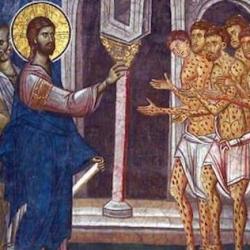In her After Writing, Catherine Pickstock argues that the Cartesian Cogito is grounded in a Cartesian ontology, which is in turn related to a Cartesian politics. According to Descartes’ Regulae, she says, “being is defined as that which is clear and distinct, available to absolute and certain intuitions, and ‘perfectly known and incapable of being doubted.’ Existence becomes a ‘simple’ or common notion, which, along with ‘unity’ and ‘duration,’ is univocally common to both corporeal things and to spirits.” These distinct and clearly-known objects can be mapped in a comprehensive mathesis, “modelled on the abstract and timeless certainty of arithmetic and geometry” (62–3).
This is the background to Descartes’s claim that material reality is extensio, “an homogenous quantity divided into degrees of motion and mechanical causes, and fully grasped in its ‘givenness.’” Qualities like color – inevitable indistinct and hazy – are “reduced to abstract spatial quantities” (63). Gone in this ontology is any conception (whether Platonic or Christian or some combination of the two) of a “depth” to material reality, an ungraspable “spiritual” reality that is beyond our grasp. Descartes “drains extension or corporeality itself of all its force and power.” Immanentizing reality, or materializing reality, paradoxically end up with the erasure of matter and reality. The “secular ‘given’ of the universal method is purely formal, articulated only in abstract structures which do not coincide with any actual embodied reality. But what is an immanentized ideal except the nihil, something which vanishes the moment it is posited?” (67). Nihilism is a deviation from Cartesian ontology but inherent in it.
Pickstock recognizes here a primitive gesture of purification. Once the thinking thing thinks anything in particular, it is no longer graspable and simple, no longer certain. It gets lost in the uncertainties of actual thought. In its purity the Cartesian subject is modeled on the Cartesian city, a planned urban space with clear lines dividing inside from outside. Descartes commends the ideal of Sparta, since it was “devised by a single man and hence all tended to the same end” (quoted 58).
Sparta’s military is set up for the “defense of its own absolute interior,” and is also a fitting sign of a metaphysics that, as Derrida realized, was “the preservation of interiority, of reason as monadic self-presence, and of the city as a pristine enclosure which must resort to the expulsion of the impure. For in the case of the Cartesian city, the impure is represented as that which bears the traces of time, multiplicity, and difference, in the form of the emergent structures of ancient cities, organic legal systems, and philosophical and pedagogical traditions. To such instances of impurity, Descartes response with a violent gesture of demolition” (59).
The Cartesian subject is a Spartan: He reasons best in solitude, according to a method that clears out anything impure that might contaminate his quest for certainty. The Spartan philosopher rejects “the diverse books ‘compounded and amassed little by little from the opinions of many different persons.’” He relies instead on “the simple reasoning which a man of good sense naturally makes.” He thus reaches a pure knowledge, purified of history and the complications of language (60).
Whether or not Pickstock has Descartes right I cannot say. But she does show the inner connection between the “self-enclosed, self-identical” subject and the postmodern nihil-subject. And she implies that the former leads to the latter because of a stoicheic decision of purification that ends up clearing away the “contaminants” of time, history, language and relation that make the subject a subject in the first place.















